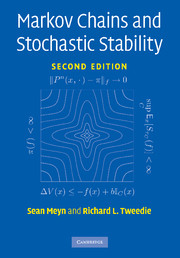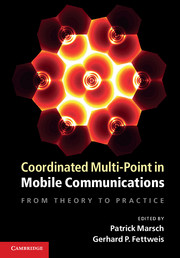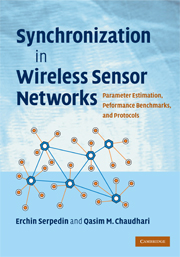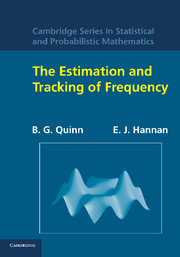Refine search
Actions for selected content:
6791 results in Communications and signal processing
1 - Beginnings
-
- Book:
- Essentials of Mobile Handset Design
- Published online:
- 05 October 2012
- Print publication:
- 30 August 2012, pp 1-34
-
- Chapter
- Export citation
Appendix User interaction and experience design phases
-
- Book:
- Essentials of Mobile Handset Design
- Published online:
- 05 October 2012
- Print publication:
- 30 August 2012, pp 229-230
-
- Chapter
- Export citation

Markov Chains and Stochastic Stability
-
- Published online:
- 05 August 2012
- Print publication:
- 02 April 2009

Waveform Design for Active Sensing Systems
- A Computational Approach
-
- Published online:
- 05 August 2012
- Print publication:
- 12 July 2012

Information Theory
- Coding Theorems for Discrete Memoryless Systems
-
- Published online:
- 05 August 2012
- Print publication:
- 30 June 2011

Coordinated Multi-Point in Mobile Communications
- From Theory to Practice
-
- Published online:
- 05 August 2012
- Print publication:
- 21 July 2011

Synchronization in Wireless Sensor Networks
- Parameter Estimation, Performance Benchmarks, and Protocols
-
- Published online:
- 05 August 2012
- Print publication:
- 30 July 2009

The Estimation and Tracking of Frequency
-
- Published online:
- 05 August 2012
- Print publication:
- 05 February 2001
15 - Wideband transmit beampattern synthesis
- from Part III - Transmit beampattern synthesis
-
- Book:
- Waveform Design for Active Sensing Systems
- Published online:
- 05 August 2012
- Print publication:
- 12 July 2012, pp 222-244
-
- Chapter
- Export citation
Notation
-
- Book:
- Waveform Design for Active Sensing Systems
- Published online:
- 05 August 2012
- Print publication:
- 12 July 2012, pp xiii-xiii
-
- Chapter
- Export citation
19 - Covert underwater acoustic communications – noncoherent scheme
- from Part IV - Diverse application examples
-
- Book:
- Waveform Design for Active Sensing Systems
- Published online:
- 05 August 2012
- Print publication:
- 12 July 2012, pp 280-300
-
- Chapter
- Export citation
Part III - Transmit beampattern synthesis
-
- Book:
- Waveform Design for Active Sensing Systems
- Published online:
- 05 August 2012
- Print publication:
- 12 July 2012, pp 185-186
-
- Chapter
- Export citation
Part II - Periodic correlation synthesis
-
- Book:
- Waveform Design for Active Sensing Systems
- Published online:
- 05 August 2012
- Print publication:
- 12 July 2012, pp 147-148
-
- Chapter
- Export citation
11 - Lower bounds for periodic sequences
- from Part II - Periodic correlation synthesis
-
- Book:
- Waveform Design for Active Sensing Systems
- Published online:
- 05 August 2012
- Print publication:
- 12 July 2012, pp 168-174
-
- Chapter
- Export citation
1 - Introduction
-
- Book:
- Waveform Design for Active Sensing Systems
- Published online:
- 05 August 2012
- Print publication:
- 12 July 2012, pp 1-14
-
- Chapter
- Export citation
16 - Radar range and range–Doppler imaging
- from Part IV - Diverse application examples
-
- Book:
- Waveform Design for Active Sensing Systems
- Published online:
- 05 August 2012
- Print publication:
- 12 July 2012, pp 247-258
-
- Chapter
- Export citation
7 - Cross ambiguity function (CAF)
- from Part I - Aperiodic correlation synthesis
-
- Book:
- Waveform Design for Active Sensing Systems
- Published online:
- 05 August 2012
- Print publication:
- 12 July 2012, pp 106-122
-
- Chapter
- Export citation
6 - Ambiguity function (AF)
- from Part I - Aperiodic correlation synthesis
-
- Book:
- Waveform Design for Active Sensing Systems
- Published online:
- 05 August 2012
- Print publication:
- 12 July 2012, pp 88-105
-
- Chapter
- Export citation
Contents
-
- Book:
- Waveform Design for Active Sensing Systems
- Published online:
- 05 August 2012
- Print publication:
- 12 July 2012, pp v-x
-
- Chapter
- Export citation
10 - Periodic sequence set design
- from Part II - Periodic correlation synthesis
-
- Book:
- Waveform Design for Active Sensing Systems
- Published online:
- 05 August 2012
- Print publication:
- 12 July 2012, pp 158-167
-
- Chapter
- Export citation
